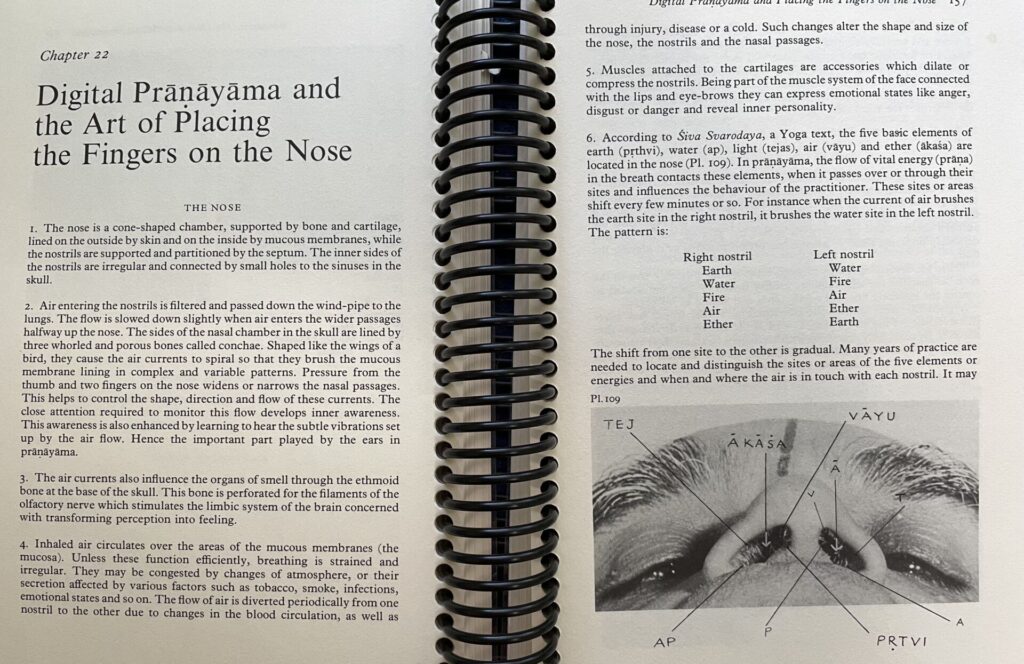Necessary Nose Breath

Image from Light on Pranayama by BKS Iyengar – Chapter 22 highlighting the complexity and sensitivity of the nostrils and the use of the fingers to fully benefit from the practices of digital pranayama – using the fingers to manipulate the nostrils for different breath regulation.
“To breathe is to absorb ourselves in what surrounds us, to take in little bits of life, understand them, and give pieces of ourselves back out. Respiration is, at its core, reciprocation.” James Nestor, Chapter 3 of BREATH
On our second week reading BREATH by James Nestor, he gives the anecdote to the mayhem caused by mouth breathing. He gets to un-stuff his nose and experiment with taping his mouth shut at night for the maximum effect and benefit of nose breathing.
“The nose is crucial because it clears air, heats it, and moistens it for easier absorption.”
BREATH by James Nestor – Chapter 3
But nose breathing is not just for those simple above purposes. Nestor goes on to explain that within the delicate complexity of the nasal passages you will also find relationships to erectile dysfunction, the power to lower blood pressure and ease digestion, relationships to a woman’s menstrual cycle, regulation of heart rate, etc…He even reminds us that the nose is more related to our genitals than probably most of us would like to admit.
This chapter once again brings in the knowledge of ancient yogis, and references other religious texts such as the Bible and Taoism that indicate the importance and power of the breath. For yogis, the breath is our individual connection to the Universal life force (prana) that runs through all of Nature. They knew that nasal passages cycle throughout the day and within sun and moon cycles, so harnessed that balancing power by specific Pranayamas (breath regulations) such as nadi shodhana and surya bhedana. They also knew the connection of the movement of breath through the nostrils to the workings of our nervous system and energetic systems. The right nostril, the “gas pedal” corresponding to the sympathetic nervous system, heats up the body and energizes the mind. The left nostril has a cooling and calming effect more connected to the parasympathetic nervous system. Many yoga teachers ask you to “roll to the right side” when you are finished with your Savasana (relaxation pose), serving the purpose of keeping the right side of the nostril and body more closed to continue the quietness found in your relaxation.
The rest of the chapter goes into great detail about the physical changes and actual health benefits that come with nose breathing.
“In a single breath, more molecules of air will pass through your nose than all the grains of sand on all the world’s beaches…the nose is the silent warrior: the gatekeepeer of our bodies, pharmacists to our minds, and weather vane to our emotions.”
BREATH by James Nestor – Chapter 3
Westerners only began to know the power of nostril breathing in the mid-1800s through the eyes, writings, and portraits of a researcher and artist named George Catlin. Being someone who suffered from extreme respiratory issues, he was struck by the lack of disease and dental issues in the tribes he encountered. Through his time traveling and experiencing, he came to the conclusion that “The air which enters the lungs is as different from that which enters the nostrils as distilled water is different from the water in an ordinary cistern or frog pond.” (Chapter 3) Practices were utilized amongst the tribes to train babies to nose breathe, and to this day certain doctors use taping the mouth shut during the night to heal patients from extreme issues of sleep apnea and/or snoring.
The dramatic difference in mouth breathing and nose breathing was experienced by Nestor and his friend joining him in the breathing experiment. I look forward to other anecdotes he will share about breathing in the rest of the book. Hope you are enjoying reading along this summer and maybe we should all take Catlins’s official motto for the human race to heart for our own health and wellbeing …
“SHUT-YOUR-MOUTH” (Breath of Life by George Catlin)